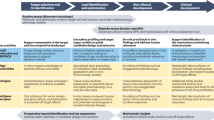Abstract
As indicated elsewhere in this book1, the first substantial official or quasi-official pronouncement on the conduct and interpretation of toxicity tests — of the kind relevant to safety evaluation — was made in 1955 by the staff of the US Food and Drug Administration2. With the thalidomide episode, legislation and codes of practice were introduced into or expanded by many countries, with in many instances the issue of guidelines for the type of testing regarded as necessary.
Access this chapter
Tax calculation will be finalised at checkout
Purchases are for personal use only
Preview
Unable to display preview. Download preview PDF.
Similar content being viewed by others
References
Worden AN (1986). The evidence supporting 6-month studies. In Walker SR and Dayan AD (eds) Long-term Animal Studies: their Predictive Value for Man. (Lancaster: MTP Press), pp. 83–86
Association of Food and Drug Officials of the United States (1955). Appraisal of the Safety of Chemicals in Foods, Drugs and Cosmetics. (Topeka, Kansas: Association of Food and Drug Officials of the United States, PO Box 1494)
Paget GE (ed) (1977). Quality Control in Toxicology. (Lancaster: MTP Press)
Medicines Act 1968, Chapter 67. ISBN 0–10-546768 5. (London: HMSO); see also Medicines Act Leaflets, (London: DHSS Medicines Division, Market Towers, 1 Nine Elms Lane, London SW8 5NQ)
Department of Health and Social Security (1986). Guidance on the Preparation of Data on Chemicals in Foods, Consumer Products and the Environment Submitted to the DHSS. Report on Health and Social Services, 30. (London: HMSO)
Data Requirements for Approval under the Control of Pesticides Regulations (1986). (London: MAFF) October.
Notification of New Substances Regulations 1982 (SI 1982 No 1496); (1981). See also Notification of new substances: Draft regulations and approved codes of practice, Health and Safety Commission Consultative Document. ISBN 0–11-883420 7. (London: HMSO)
Arrêté du 21 fevrier 1980 portant agrément d’experts analysts, pharmacologues-toxicologues et cliniciens pour les essais des spécialités pharmaceutiques (1980). Bulletin Officiel du Ministère de la Santé et de la Sécurité Sociale, Fasc. 80/10, Texts 18193–18228, 5 April.
See relevant Medicines Act Leaflets, cited in reference 4
Commission of the European Communities Council Directive 83/570/EEC (1985). See Notice to Applicants for Marketing Authorization for Proprietary Medicinal Products in the Member States of the European Community on the Use of the New Multistate Procedure. (Brussels: Directorate-General for Internal Marketing and Industrial Affairs, Communour of the European Committee, rue de la Loi 200, B-1049), July
Balls M, Riddell RJ and Worden AN (eds) (1983). Animals and Alternatives in Toxicity Testing. (London: Academic Press)
Griffin JP (1985). A comparison between guidelines on preclinical safety evaluation of medicinal products of the European Community, the Nordic countries, and Japan. ATLA, 13, 53–63
Cockburn A (1983). The need for flexibility. In Balls M et al. (eds). Animals and Alternatives in Toxicity Testing. (London: Academic Press), pp. 457–9
Conning DM (1983). Rapporteur on General Discussion on Regulations. In Balls M et al. (eds) Animals and Alternatives in Toxicity Testing. (London: Academic Press), pp. 467–9
Worden AN (1983). Consultation with the regulatory authorities. In Balls M et al. (eds) Animals and Alternatives in Toxicity Testing. (London: Academic Press), pp. 459–61 (ref. 11)
Parkes DVW (1983). Regulatory aspects. In Balls M et al. (eds) Animals and Alternatives in Toxicity Testing. (London: Academic Press), pp. 445–56
Chatfield DH and Green JN (1978). Disposition and metabolism of benoxaprofen in laboratory animals and man. Xenobiotica, 8, 133–44
Wardell WM (1978). The drug lag revisited: comparison by therapeutic area of patterns of drugs marketed in the United States and Great Britain from 1972 through 1976. Clin Pharmacol Ther, 24, 499–594
Editor information
Editors and Affiliations
Rights and permissions
Copyright information
© 1987 MTP Press Limited
About this chapter
Cite this chapter
Worden, A.N. (1987). The Organization of Preclinical and Premarketing Toxicity Testing. In: Worden, A.N., Parke, D.V., Marks, J. (eds) The Future of Predictive Safety Evaluation. Springer, Dordrecht. https://doi.org/10.1007/978-94-009-3201-2_2
Download citation
DOI: https://doi.org/10.1007/978-94-009-3201-2_2
Publisher Name: Springer, Dordrecht
Print ISBN: 978-94-010-7936-5
Online ISBN: 978-94-009-3201-2
eBook Packages: Springer Book Archive




